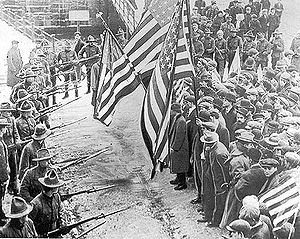
This Day in Labor History: February 23, 1959. The AFL-CIO Executive Council, meeting in San Juan, Puerto Rico, passed a resolution to create the Agricultural Workers Organizing Committee, an early attempt to organize the farmworkers at the bottom of the American labor force!! 

While Americans idealized agricultural work from the Jeffersonian beginnings of the nation, underlying the agrarian myth was very hard work. For Jefferson himself, that work was done by enslaved black labor.
The family farm was a real thing in America of course and was the fundamental basis of free labor ideology that fed northern beliefs about capitalism and was the base reason why northerners opposed the expansion of slavery.
After all, if slavery was the future of the nation, where was the room for the independent white farmer? But farmers were as enmeshed in rapacious capitalism as anyone else and they really started feeling that in the Gilded Age, leading to the Farmers’ Alliance and the Populists.
In the arid and semi-arid American West, family farms definitely existed–the Japanese were well known and resented for taking land whites thought were unproductive and turning them into really productive farms.
But big corporate agriculture became dominant in the early twentieth century, especially in California.
Those big farmers relied on cheap, pliable labor and would do anything to get it, including lie to workers about jobs to recruit too many and lower prices and then use the police to crush workers when they organized around it, as what happened in what led to the Wheatland Riot.
There were occasional attempts to unite the different races working in the fields, such as the Japanese-Mexican Labor Association, but they were hard to maintain against the violence.
By the Great Depression, there were early attempts to organize the increasingly Mexican workers.
The United Cannery, Agricultural, Packing, and Allied Workers of America (UCAPAWA) formed in 1937 as a multiracial union to organize the food workers of the Southwest and did some pretty amazing work before being redbaited out of existence.
The arrival of a lot of conservative white migrants from the South fleeing their eviction off tenant farms due to the Agricultural Adjustment Act definitely did not help UCAPAWA’s organizing efforts.
During World War II, the government attempted to “solve” the agricultural worker problem through the incredibly exploitative Bracero program, which brought guestworkers, mostly from Mexico, to the United States, to work on the farms.
This was a horrible labor system that gave workers no rights or recourse to the massive racism, wage theft, unsafe working conditions, and unsanitary living conditions they faced.
By 1959, it was clear the Bracero program was on its last legs and the AFL-CIO decided to act and move toward some organizing campaigns in the fields.
AWOC had its first base among the aging Filipino farmworkers who had been laboring in the fields for several decades, before the Tydings-McDuffie Act ended Filipino migration.
That set the Philippines on the course of independence because Filipino men and white women were having sex and Americans decided that colonialism was not worth the price of interracial sex.
America: too racist for colonization.
America: too racist for colonization.
The union’s most important leader was Larry Itliong, who sought to end the Bracero Program and have agricultural workers be laborers that could be organized into unions.
The long-time Filipino organizer who had lost three fingers in an Alaskan salmon cannery, had led the 1948 asparagus strike in California, served as shop steward of ILWU Local 37 in Seattle, and who founded the Filipino Farm Labor Union in 1956, was the clear leader.
AWOC’s first big action was the 1961 lettuce workers strike, in which the went after both the growers and the Braceros, using the clause in the Bracero Program that they couldn’t serve as strikebreakers to specifically target farms where they worked.
Meany didn’t like the bad publicity this caused and he tried to shut down AWOC in the aftermath, but it struggled along for a few more years. By 1965, Itliong was the head of AWOC.
The biggest challenge they faced was Mexican farmworkers being willing to break Filipino farm workers strike. But this changed in 1965 with the Delano strike, where Cesar Chavez first came to the attention of the nation.
Chavez’s National Farm Workers Association joined AWOC on the picket lines.
Soon, the two organizations merged into the United Farm Workers. Itliong was rightfully concerned that the needs of the aging Filipino workers would be subsumed under the majority Mexican UFW membership and that in fact did happen.
But it was perhaps inevitable, as AWOC as a strictly Filipino organization did not have staying power because of demographics if nothing else. Itliong finally broke from Chavez in 1971 and resigned from the union’s executive board.
Back tomorrow to discuss the Bread and Roses strike in Lawrence, Massachusetts!
And if you want some more labor history, I'm giving a talk on Thursday night so sign up!
rihs.org/event/virtual-…
rihs.org/event/virtual-…
• • •
Missing some Tweet in this thread? You can try to
force a refresh






